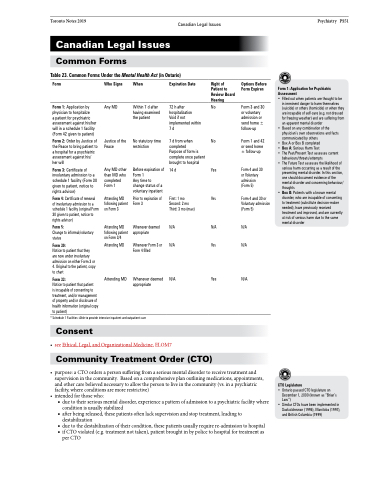Page 1215 - TNFlipTest
P. 1215
Toronto Notes 2019 Canadian Legal Issues Canadian Legal Issues
Psychiatry PS51
Form 1: Application for Psychiatric Assessment
• Filled out when patients are thought to be
in imminent danger to harm themselves (suicide) or others (homicide) or when they are incapable of self-care (e.g. not dressed for freezing weather) and are suffering from an apparent mental disorder
• Based on any combination of the physician’s own observations and facts communicated by others
• Box A or Box B completed
• Box A: Serious Harm Test
• The Past/Present Test assesses current
behaviours/threats/attempts
• The Future Test assesses the likelihood of
serious harm occurring as a result of the presenting mental disorder. In this section, one should document evidence of the mental disorder and concerning behaviour/ thoughts
• Box B: Patients with a known mental disorder, who are incapable of consenting to treatment (substitute decision-maker needed), have previously received treatment and improved, and are currently at risk of serious harm due to the same mental disorder
Common Forms
Table 23. Common Forms Under the Mental Health Act (in Ontario)
Form
Form 1: Application by physician to hospitalize
a patient for psychiatric assessment against his/her will in a schedule 1 facility (Form 42 given to patient)
Form 2: Order by Justice of the Peace to bring patient to a hospital for a psychiatric assessment against his/
her will
Form 3: Certificate of involuntary admission to a schedule 1 facility (Form 30 given to patient, notice to rights advisor)
Form 4: Certificate of renewal of involuntary admission to a schedule 1 facility (original Form 30 given to patient, notice to rights advisor)
Form 5:
Change to informal/voluntary status
Form 30:
Notice to patient that they are now under involuntary admission on either Form 3 or 4. Original to the patient, copy to chart
Form 33:
Notice to patient that patient
is incapable of consenting to treatment, and/or management of property and/or disclosure of health information (original copy to patient)
Who Signs
Any MD
Justice of the Peace
Any MD other than MD who completed Form 1
Attending MD following patient on Form 3
Attending MD following patient on Form 3/4
Attending MD
Attending MD
When
Within 7 d after having examined the patient
No statutory time restriction
Before expiration of Form 1
Any time to change status of a voluntary inpatient
Prior to expiration of Form 3
Whenever deemed appropriate
Whenever Form 3 or Form 4 filled
Whenever deemed appropriate
Expiration Date
72 h after hospitalization
Void if not implemented within 7d
7 d from when completed
Purpose of form is complete once patient brought to hospital
14 d
First: 1 mo Second: 2 mo Third: 3 mo (max)
N/A N/A
N/A
Right of Patient to Review Board Hearing
No
No
Yes
Yes
N/A Yes
Yes
Options Before Form Expires
Form 3 and 30 or voluntary admission or send home ± follow-up
Form 1 and 42 or send home ± follow-up
Form 4 and 30 or Voluntary admission (Form 5)
Form 4 and 30 or Voluntary admission (Form 5)
N/A N/A
N/A
* Schedule 1 Facilities: Able to provide intensive inpatient and outpatient care
Consent
• seeEthical,Legal,andOrganizationalMedicine,ELOM7 Community Treatment Order (CTO)
• purpose:aCTOordersapersonsufferingfromaseriousmentaldisordertoreceivetreatmentand supervision in the community. Based on a comprehensive plan outlining medications, appointments, and other care believed necessary to allow the person to live in the community (vs. in a psychiatric facility, where conditions are more restrictive)
• intendedforthosewho:
■ due to their serious mental disorder, experience a pattern of admission to a psychiatric facility where
condition is usually stabilized
■ after being released, these patients often lack supervision and stop treatment, leading to
destabilization
■ due to the destabilization of their condition, these patients usually require re-admission to hospital ■ if CTO violated (e.g. treatment not taken), patient brought in by police to hospital for treatment as
CTO Legislature
• Ontario passed CTO legislature on December 1, 2000 (known as “Brian’s Law”)
• Similar CTOs have been implemented in Saskatchewan (1995), Manitoba (1997), and British Columbia (1999)
per CTO


